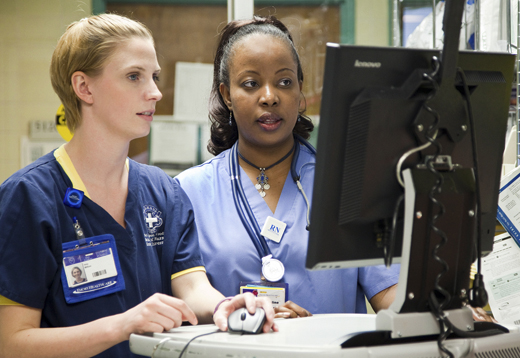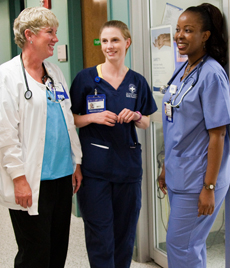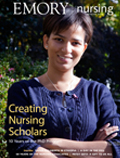A day in the DEU

Above: Nursing senior Ivey Milton (left) checks on a patient’s medication, guided by Jackie Kandaya, her medical-surgical instructor at Emory University Hospital Midtown.
A new education model exposes students to real-world health care

Kelly Brewer (left) holds a joint appointment with the School of Nursing and Emory Healthcare as DEU coordinator. She matches students like Ivey Milton (center) with seasoned staff nurses like Jackie Kandaya (right). |
Nursing senior Ivey Milton had a change of heart this year about her future. When Milton entered nursing school, she wanted to specialize in women’s health. But her aspirations shifted partially, if not completely, after she worked in Emory’s new Dedicated Education Unit (DEU).
Launched by the School of Nursing and Emory Healthcare last fall, the DEU pairs a nursing student with a staff nurse for one-on-one clinical instruction in the medical-surgical unit at Emory University Hospital (EUH) or Emory University Hospital Midtown (EUHM).
Every Tuesday for eight weeks, Milton worked a 12-hour shift on unit 51 at EUHM. With 51 beds, the unit houses diverse patients with diverse challenges. But Milton’s apprehension subsided under the guidance of clinical instructor Jackie Kandaya, one of the unit’s shift nurse managers.
“I was nervous about the medical-surgical floor at first,” says Milton. “But I thought the DEU would make my rotation more interesting because I could work regularly with a nurse who knows the system. That helped me overcome my fears and get more out of the experience.”
Teaching Milton proved stimulating for Kandaya, who attended a nursing school in England that used the DEU model. Impressed with the concept, she embraced it at EUHM to mentor future nurses and grow professionally.
“We teach patients all the time,” says Kandaya. “But teaching Ivey and my other two students kept me on my toes. They asked lots of questions. I had to stay two steps ahead of them to challenge them and make sure they had a positive experience.”
A first at Emory and in Georgia, the DEU is based on the model implemented by the University of Portland School of Nursing and its clinical partners in the early 2000s. The concept originated in Australia a few years earlier to address mounting dissatisfaction with how nursing students were clinically trained. The University of Portland adopted the concept to address a critical shortage of nurses, faculty, and clinical sites to support a rapidly growing number of students.
In 2007, members of a joint School of Nursing/Emory Healthcare task force attended a DEU symposium at Portland. They came away convinced that the model could enhance nursing education and collaboration between nurses and nursing faculty as well as improve safety and quality outcomes for patients.
When Emory rolled out the model last fall, 18 nursing seniors applied to work in the DEU for their medical-surgical rotation. Before joining their units, students attended an orientation to learn about the nursing concepts central to Emory Healthcare—quality, safety, patient- and family-centered care, shared decision-making, and the synergy model of patient care, which matches patients’ needs with nurses’ competencies.
“Our DEU initiative relies on these concepts and the skills of nurses and faculty to help students transition into the real world of nursing,” says Kelly Brewer, who holds a joint appointment with the School of Nursing and Emory Healthcare as DEU coordinator. “It’s a win-win situation for both sets of professionals since faculty and clinical nurses are in short supply because of the nursing shortage.”
Brewer’s role with the DEU grew out of her experience as a clinical instructor in the nursing school, clinical practice as an RN, and the possibilities she saw at the Portland symposium. Last fall, seven staff nurses served as Emory DEU clinical instructors. As more staff nurses come on board as instructors, more students will be able to experience the DEU model.
The Emory DEU should provide other benefits. “In Portland, nursing faculty and staff found that nurses who work on the DEU are happier and stay longer,” says Brewer. “Students often come back to work after graduation, so the DEU is a great retention and recruitment tool.
“Both of our hospitals are committed to making students feel that they are part of the unit so they’ll want to work there after they graduate,” she adds. “They will already have a sense of what Emory’s health care system is about, and their transition into the real world of health care will be less stressful.”
There’s no hanging back for students in the DEU. During Milton’s weekly shift at EUHM, she took charge of two patients, taking vital signs, assessing them, checking orders, giving meds and baths, scheduling treatments and tests, admitting them and educating them before discharge. She also learned how to interact with patients and deal with the unexpected, such as the patient who codes or has a GI bleed. Her instructor stayed within arm’s reach.
“Those cases are serious, but they are good experiences for students,” says Kandaya. “It provides a real-life example of how to handle a patient who is coding while you’re juggling three others.”
Milton agrees. “Med-surge is my favorite rotation so far,” she says. “I loved seeing how Jackie deals with patients and works with the system. I had some patients more than once, so I was able to develop a relationship with them. That meant a lot to me and the patient.”
The experience was just as meaningful for Kandaya, who watched her students’ skill and confidence levels climb. “The students become more independent and are able to use sound judgment,” she says. “I was able to step aside and observe them. It’s like watching your kids go off to college. ”—Pam Auchmutey


